The Intel Xeon W-3175X Review: 28 Unlocked Cores, $2999
by Ian Cutress on January 30, 2019 9:00 AM ESTCPU Performance: Web and Legacy Tests
While more the focus of low-end and small form factor systems, web-based benchmarks are notoriously difficult to standardize. Modern web browsers are frequently updated, with no recourse to disable those updates, and as such there is difficulty in keeping a common platform. The fast paced nature of browser development means that version numbers (and performance) can change from week to week. Despite this, web tests are often a good measure of user experience: a lot of what most office work is today revolves around web applications, particularly email and office apps, but also interfaces and development environments. Our web tests include some of the industry standard tests, as well as a few popular but older tests.
We have also included our legacy benchmarks in this section, representing a stack of older code for popular benchmarks.
All of our benchmark results can also be found in our benchmark engine, Bench.
For our graphs, some of them have two values: a regular value in orange, and one in red called 'Intel Spec'. ASUS offers the option to 'open up' the power and current limits of the chip, so the CPU is still running at the same frequency but is not throttled. Despite Intel saying that they recommend 'Intel Spec', the system they sent to us to test was actually set up with the power limits opened up, and the results they provided for us to compare to internally also correlated with that setting. As a result, we're providing both sets results for our CPU tests.
WebXPRT 3: Modern Real-World Web Tasks, including AI
The company behind the XPRT test suites, Principled Technologies, has recently released the latest web-test, and rather than attach a year to the name have just called it ‘3’. This latest test (as we started the suite) has built upon and developed the ethos of previous tests: user interaction, office compute, graph generation, list sorting, HTML5, image manipulation, and even goes as far as some AI testing.
For our benchmark, we run the standard test which goes through the benchmark list seven times and provides a final result. We run this standard test four times, and take an average.
Users can access the WebXPRT test at http://principledtechnologies.com/benchmarkxprt/webxprt/
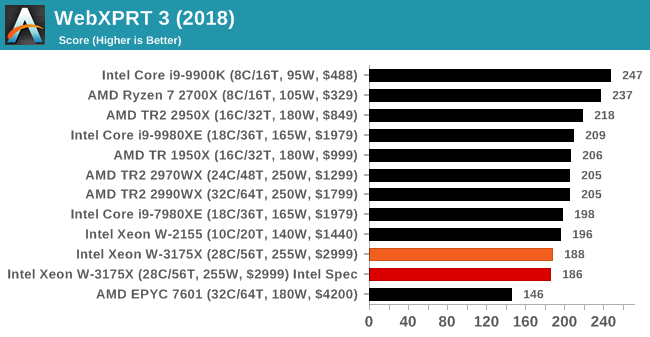
WebXPRT 2015: HTML5 and Javascript Web UX Testing
The older version of WebXPRT is the 2015 edition, which focuses on a slightly different set of web technologies and frameworks that are in use today. This is still a relevant test, especially for users interacting with not-the-latest web applications in the market, of which there are a lot. Web framework development is often very quick but with high turnover, meaning that frameworks are quickly developed, built-upon, used, and then developers move on to the next, and adjusting an application to a new framework is a difficult arduous task, especially with rapid development cycles. This leaves a lot of applications as ‘fixed-in-time’, and relevant to user experience for many years.
Similar to WebXPRT3, the main benchmark is a sectional run repeated seven times, with a final score. We repeat the whole thing four times, and average those final scores.
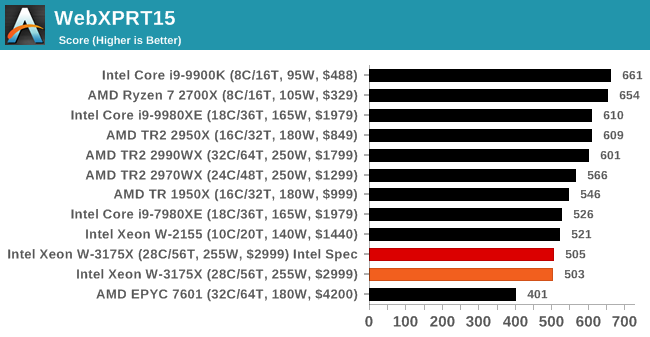
Speedometer 2: JavaScript Frameworks
Our newest web test is Speedometer 2, which is a accrued test over a series of javascript frameworks to do three simple things: built a list, enable each item in the list, and remove the list. All the frameworks implement the same visual cues, but obviously apply them from different coding angles.
Our test goes through the list of frameworks, and produces a final score indicative of ‘rpm’, one of the benchmarks internal metrics. We report this final score.

Google Octane 2.0: Core Web Compute
A popular web test for several years, but now no longer being updated, is Octane, developed by Google. Version 2.0 of the test performs the best part of two-dozen compute related tasks, such as regular expressions, cryptography, ray tracing, emulation, and Navier-Stokes physics calculations.
The test gives each sub-test a score and produces a geometric mean of the set as a final result. We run the full benchmark four times, and average the final results.
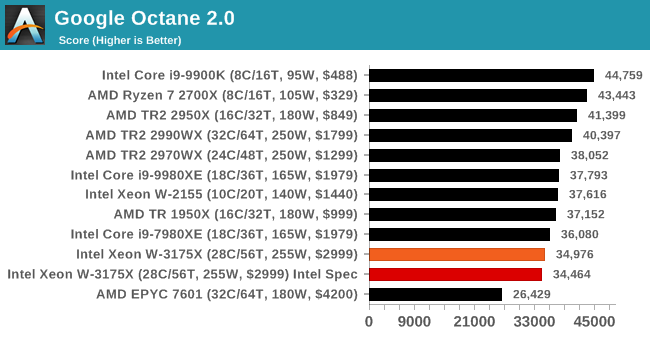
Mozilla Kraken 1.1: Core Web Compute
Even older than Octane is Kraken, this time developed by Mozilla. This is an older test that does similar computational mechanics, such as audio processing or image filtering. Kraken seems to produce a highly variable result depending on the browser version, as it is a test that is keenly optimized for.
The main benchmark runs through each of the sub-tests ten times and produces an average time to completion for each loop, given in milliseconds. We run the full benchmark four times and take an average of the time taken.
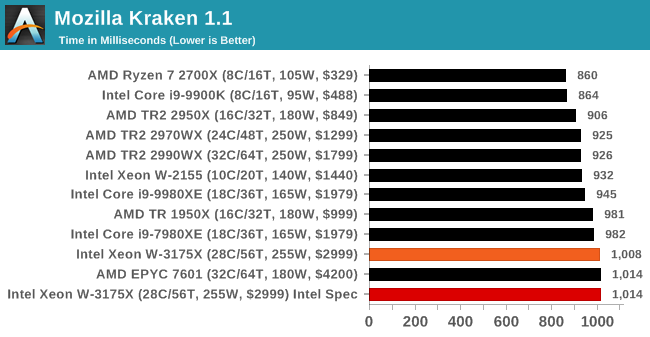
3DPM v1: Naïve Code Variant of 3DPM v2.1
The first legacy test in the suite is the first version of our 3DPM benchmark. This is the ultimate naïve version of the code, as if it was written by scientist with no knowledge of how computer hardware, compilers, or optimization works (which in fact, it was at the start). This represents a large body of scientific simulation out in the wild, where getting the answer is more important than it being fast (getting a result in 4 days is acceptable if it’s correct, rather than sending someone away for a year to learn to code and getting the result in 5 minutes).
In this version, the only real optimization was in the compiler flags (-O2, -fp:fast), compiling it in release mode, and enabling OpenMP in the main compute loops. The loops were not configured for function size, and one of the key slowdowns is false sharing in the cache. It also has long dependency chains based on the random number generation, which leads to relatively poor performance on specific compute microarchitectures.
3DPM v1 can be downloaded with our 3DPM v2 code here: 3DPMv2.1.rar (13.0 MB)

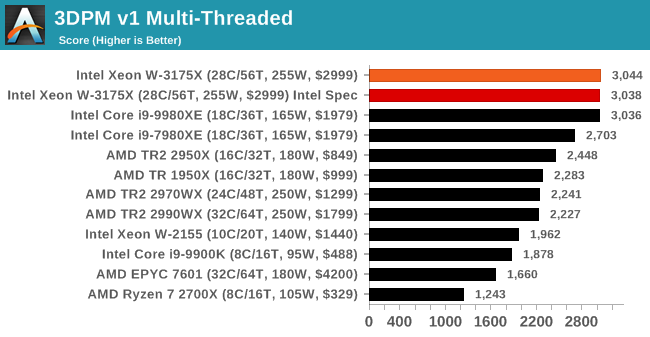
x264 HD 3.0: Older Transcode Test
This transcoding test is super old, and was used by Anand back in the day of Pentium 4 and Athlon II processors. Here a standardized 720p video is transcoded with a two-pass conversion, with the benchmark showing the frames-per-second of each pass. This benchmark is single-threaded, and between some micro-architectures we seem to actually hit an instructions-per-clock wall.

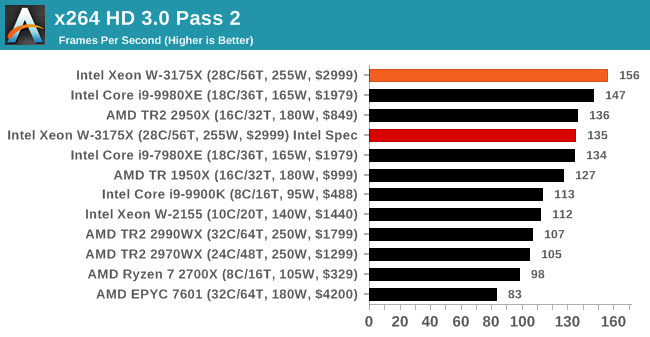










136 Comments
View All Comments
Icehawk - Thursday, January 31, 2019 - link
Yup. At the desktop level we have things like Adobe for $1k/seat/yr.Our big iron costs an order of magnitude more than these machines (recent orders were $150k ea and were mid-spec HP boxes). In the end most of the costs of a big server are memory and storage (SSDs). The high heat/energy consumption of this setup would be a concern, especially if in a colo.
jardows2 - Wednesday, January 30, 2019 - link
What are you rambling on about? It's a solid performing product, at a much reduced price than Intel's normal markup. I don't get where you come off thinking this is a fanboy post, and you totally missed my point - why is it limited to so few pieces? In Intel's lineup, it's a winner, and there are plenty of people in workstation markets who will only buy systems with Intel CPUs. So for Intel to make a good performing product, at a much lower than normal for Intel price, but only make a couple thousand of them? What's going on over there?edzieba - Thursday, January 31, 2019 - link
Because this is a cherry-picked part from a low-run die production. Intel don't make many XCC dies, and only a handful will be able to tolerate the high voltages and frequencies of this part across all 28 cores. It's also not going to be a big earner at $3000, that may break even on production but probably a loss overall when you take R&D into account.mapesdhs - Saturday, February 2, 2019 - link
A movie company I know buys systems in such bulk, a CPU/system like this wouldn't even show up on their radar. They prefer systems they can buy lots of, for multiple sites with a common setup.People are arguing here about A vs. B, about the CPU cost, but as many have pointed out it's often the sw cost and availability which determine what a company will purchase. As for workstation use, especially the prosumer market, that has its own set of issues, especially whether a particular app is written well enough to exploit so many cores. Blender is, but Premiere isn't.
FMinus - Friday, February 1, 2019 - link
Or you can get two TR 2970W system and make them work in tandem for what I would think would be almost half the price at this point, considering you can buy this Intel gem only pre-built for probably well bloated prices.SanX - Friday, February 1, 2019 - link
Intel are killing good at particle movement -- 4x faster then TR2. Till AMD makes AVX512 they are still dead for scienceET - Wednesday, January 30, 2019 - link
I find it amazing how application dependent performance is. Whether a product is a good buy depends so much on precisely what you're going to do with it, down to the application level.Still, on the whole, it looks like Intel has little to offer over AMD's much cheaper Threadripper platform.
BigMamaInHouse - Wednesday, January 30, 2019 - link
I think soon we gonna see "Leaks" about new TR64 cores, this "5GHZ 28C" stunt made AMD to release 2990WX instead just 24C 2970WX, now after the Fail attempt by Intel - We gonna see new leaks :-).FMinus - Friday, February 1, 2019 - link
Considering AMD was attending the same trade show, where Intel announced this 28 core chip and AMD a day later announced the new TR lineup, I'd say AMD planned to release the 2990WX regardless of what Intel had.mapesdhs - Saturday, February 2, 2019 - link
Yes, but the tinfoil hat industry is strong. :D